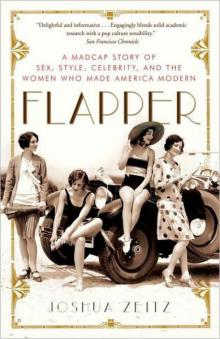Flapper: A Madcap Story of Sex, Style, Celebrity & the Women Who Made America Modern 

by Joshua Zeitz
Genre: Other5
Published: 2007
View: 2789
Read OnlineRead Flapper: A Madcap Story of Sex, Style, Celebrity & the Women Who Made America Modern Storyline:
Blithely flinging aside the Victorian manners that kept her disapproving mother corseted, the New Woman of the 1920s puffed cigarettes, snuck gin, hiked her hemlines, danced the Charleston, and necked in roadsters. More important, she earned her own keep, controlled her own destiny, and secured liberties that modern women take for granted. Her newfound freedom heralded a radical change in American culture.Whisking us from the Alabama country club where Zelda Sayre first caught the eye of F. Scott Fitzgerald to Muncie, Indiana, where would-be flappers begged their mothers for silk stockings, to the Manhattan speakeasies where patrons partied till daybreak, historian Joshua Zeitz brings the era to exhilarating life. This is the story of America’s first sexual revolution, its first merchants of cool, its first celebrities, and its most sparkling advertisement for the right to pursue happiness.The men and women who made the flapper were a diverse lot. There was Coco Chanel, the French orphan who redefined the feminine form and silhouette, helping to free women from the torturous corsets and crinolines that had served as tools of social control. Three thousand miles away, Lois Long, the daughter of a Connecticut clergyman, christened herself “Lipstick” and gave New Yorker readers a thrilling entrée into Manhattan’s extravagant Jazz Age nightlife.In California, where orange groves gave way to studio lots and fairytale mansions, three of America’s first celebrities—Clara Bow, Colleen Moore, and Louise Brooks, Hollywood’s great flapper triumvirate—fired the imaginations of millions of filmgoers.Dallas-born fashion artist Gordon Conway and Utah-born cartoonist John Held crafted magazine covers that captured the electricity of the social revolution sweeping the United States.Bruce Barton and Edward Bernays, pioneers of advertising and public relations, taught big business how to harness the dreams and anxieties of a newly industrial America—and a nation of consumers was born.Towering above all were Zelda and Scott Fitzgerald, whose swift ascent and spectacular fall embodied the glamour and excess of the era that would come to an abrupt end on Black Tuesday, when the stock market collapsed and rendered the age of abundance and frivolity instantly obsolete.With its heady cocktail of storytelling and big ideas, Flapper is a dazzling look at the women who launched the first truly modern decade.From the Hardcover edition.From Publishers WeeklyThis is an entertaining, well-researched and charmingly illustrated dissection of the 1920s flapper, who flouted conventions and epitomized the naughtiness of the Jazz Age as she "bobbed her hair, smoked cigarettes, drank gin, sported short skirts, and passed her evenings in steamy jazz clubs." Cambridge historian Zeitz identifies F. Scott Fitzgerald as "the premier analyst," and his muse and wife, Zelda, "the prototype" of the American flapper. Others who invented aspects of the flapper mystique were New Yorker writer Lois Long, who gave readers a vicarious peek into the humorous late-night adventures of the New Woman; designer Coco Chanel, whose androgynous fashions redefined feminine sexuality as they blurred the line between men's and women's roles in society; fashion artist Gordon Conway, whose willowy and aloof flappers were seen by millions of American and European magazine readers; and Clara Bow, who breathed life into the flapper on the silver screen. The Klan, Zeitz relates, denounced flappers as evils of the modern age, and advertisers exploited the social anxieties of would-be flappers by appealing to the conformist at the heart of this controversial figure. (Mar.) Copyright © Reed Business Information, a division of Reed Elsevier Inc. All rights reserved. From BooklistStarred Review This lively history looks at the Jazz Age through its greatest symbol, the flapper. A far cry from the staid Victorian angel of the house, flappers wore their hair short, dared to show their legs, drank, smoked, and cavorted with young men. Alhough he didn't invent the flapper as many suppose, F. Scott Fitzgerald did bring the modern woman into the public eye in his debut novel, This Side of Paradise. Zeitz explores the lives of the women who have come to personify the flapper ideal: Zelda Sayre, the southern belle who married Fitzgerald and became his muse; Lois Long, the sharp-tongued New Yorker columnist whose nightlife was often the subject of her writing; Coco Chanel, the elegant designer who carefully crafted her own backstory; and the actresses Colleen Moore, Clara Bow, and Louise Brooks, who brought the flapper to the silver screen only to be left in the dust when the following decade ushered in a less sexually confident feminine ideal. Zeitz's energetic writing does his subject justice, bringing to life the wild coed parties; the colorful, glitzy fashion; and the general energy and enthusiasm with which the decade embraced modernity. An essential exploration of the women Zeitz deems "the first thoroughly modern American[s]." Kristine HuntleyCopyright © American Library Association. All rights reservedPages of Flapper: A Madcap Story of Sex, Style, Celebrity & the Women Who Made America Modern :